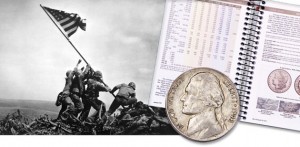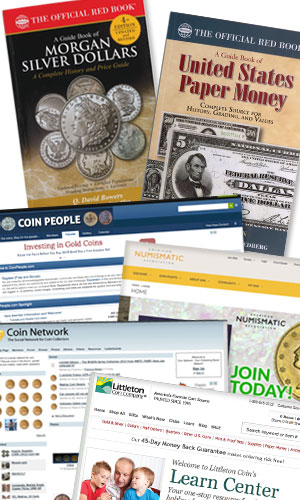Top tips to fully enjoy your coin collection!
How to get more from your hobby…
As any experienced collector will tell the more you know about your coins, the more you’ll enjoy and appreciate them. Each coin series, and each issue within a series, has its own unique story to tell.
Perhaps you own a coin from the first year of a series. Before those first coins were struck, the new series had to be approved by Congress, a design had to be chosen from various proposals, and trial strikes had to be conducted to determine the suitability of the design for coinage production. All of these behind-the-scenes procedures can be intriguing sagas…
#1 Discover the stories behind your coins
Despite the careful preparations for a new series, modifications are often made to the earliest coins. The original Lincoln cents boldly displayed designer Victor David Brenner’s V.D.B. initials on the reverse. But objections that the initials were too prominent soon brought their removal, and the original 1909 V.D.B. Lincoln cent became one of America’s most famous coins.
The first Buffalo nickels featured a bison standing on a raised mound inscribed FIVE CENTS. But the inscription wore away quickly with handling, so FIVE CENTS was placed in a protective recessed area and the prominent 1938 Variety 1 Buffalo nickel was created. The first Standing Liberty quarters in 1916 were artistically acclaimed – until criticism arose over Liberty’s exposed right breast. She was “covered up” in early 1917 and the “scandalous” Variety 1 Standing Liberty quarter was born!
#2 Learn about mintage figures and scarcity
The value of a coin is directly related to how many of the issue exist today – though popularity of the design, composition, denomination and age are also factors. A coin may be significantly scarce because it was struck in limited quantities, or because few were saved or have survived from their time of issue.
As an LCC copywriter, the first place I look to learn more about a U.S. coin I’m writing about is the latest issue of the Red Book – A Guide Book of United States Coins – which offers fast, easy access to mintage figures and relative valuations for each date, mint mark and variety in a series.
#3 Explore history associated with your coins
Series of coins as well as individual issues within a series can have special historical significance for a variety of reasons. Here are just a few examples:
- Short-lived bronze Two-Cent Pieces of 1864-1873 and nickel Three Cent Pieces of 1865-1889 were the result of a Civil War-era coin shortage and are prized mementoes from that challenging period.
-

Stories add to the coin’s value – and make them fun to talk about.
All 1909 coins with “O” mint marks are from the final year of the New Orleans Mint and are important artifacts from that historic facility. Visit LittletonCoin.com/Learn for more about the former gulf coast mint.
- Jefferson nickels of mid-1942 through 1945 were struck in a 35% silver alloy to save the strategic metal nickel for the war effort and are popular WWII collectibles see (silver wartime nickels).
- Coins dated 1859 are from the year the fabulous Comstock silver lode was discovered in western Nevada (1889 Indian Head cent), coins with 1969 dates recall the first men to walk on the moon (1969 U.S. Mint Set), and coins struck in 2000 mark the turn of a new century (first-year-of-issue 2000 Sacagawea dollar P&D set).
- Because coins display their year of issue, they are among the few dated keepsakes from specific years in history.
#4 How to learn more about your coins
There are many different numismatic or historical reasons that coins or bank notes in your collection may hold more interest than first meets the eye. So how do you go about learning what might be significant or intriguing about your coins? Here are a few suggestions…

Finding information on coins is as easy as searching the web, visiting your local bookstore or library.
Consult “the bible” about each U.S. coin. The Red Book, Whitman Publishing’s annually updated U.S. coin guide book, is nicknamed “the coin collector’s bible” and will be found at the fingertips of every experienced collector as well as every member of the LCC writing team. The Red Book contains general information about each series, mintage figures and valuations for every date, mint mark and major variety, and enlarged images of mint mark locations as well as each variety. These images are essential to properly identify coins you own and coins you may wish to purchase.
Build your own numismatic library. While the Red Book provides a good overview of U.S. coins, experienced collectors look to more in-depth reference books for important information about specific issues and varieties. Whitman’s Official Red Book Series by noted numismatic experts also offers fully illustrated collecting guides to individual series of U.S. coins, such as their Guide Book of Morgan Silver Dollars. If you also collect paper currency, check out Whitman’s Guide Book of United States Paper Money. Many other excellent specialized books are available and may be of interest to you (visit CoinWeek/Numismatic Books).
Visit respected numismatic websites. There are many online resources where collectors can learn about coins and currency – including the American Numismatic Association and Littleton’s extensive Learn Center at LittletonCoin.com/Learn. Numismatic forums where collectors can ask specific questions about coins or bank notes include Coin Talk, Coin Community, Coin People and Coin Network.
Discover America’s year-by-year history. Several websites feature year-by-year listings of significant historical events and range from brief to remarkably comprehensive. You can also find books that feature U.S. or world history timelines in any local library or bookstore. So you can easily discover the important and memorable things that happened when coins in your collection were struck!
I hope you enjoy the background information that Littleton’s writing staff provides for each coin, bank note or set featured in our catalogs and special mailings, and that it whets your appetite to learn more about coins and currency in your collection. You’ll enjoy your coins and bank notes all the more, and you’ll become a more discerning and knowledgeable collector.
Please share your thoughts and recommendations for learning about coins and currency with other collectors.





Does anyone know of a poly type coating to protect a coin art project. I have 1943 steel pennies which I do not want to turn black/lose brilliance. Thank you very much for your advice. CL
Hi Chris, we wouldn’t recommend putting any type of coating on your coins. That would most likely damage any value they have as collectibles. I’m not sure if it would work for your project, but I would suggest you check out coin capsules. Click on the link below to take a look at the coin holders we offer. Good luck! –Rick
http://bit.ly/1MzQKIM
Thank you. Chris
I JUST READ ABOUT YOUR TOPIC OF KNOWING COINS ETC. HOW DO YOU MANAGE TO REMEMBER ALL OF THE INFO ABOUT THE COINS? I’M 73 AND I JUST STARTED COLLECTING COINS TO GIVE TO ONE OF MY GREAT GRANDSONS, I DON’T HAVE THE MEMINERY TO RETAIN ALL OF THAT INFO. SO I GUESS I WANT TO KNOW IF PEOPLE THINK I’M STUPID AS KNOWLEDGEABLE COIN COLLECTERS I’M BUYING THE BOOKS LIKR YOU SAY BUT I’M ALWAYS BEHIND DATE WISE. WELL I GUESS THAT’S IT WAIT I SHIPPED SOME COINS OFF TO ANACS TO HAVE GRADED AND THE OWNER OF THE COIN STORE I BOUGHT THEM SAID I WAS WASTING MY MONEY ON THAT STUPID STUFF SO WHO IS RIGHT? THATS IS SORRY FOR THIS BEING SO LONG JAMES
Hi James, it’s great that you’ve taken up coin collecting!
When you work for a coin company like we do, you’re dealing with coins every day and it’s easy to know and remember a lot about them! Please keep in mind that you probably know more than you think about coins, and probably a lot more than most people. If what you know is enough to interest you in the coins you purchase or consider buying, that’s enough! If you’ld like to learn more you can take a look at our Learn Center. It’s a great place for the beginning collector or the expert to find lots of helpful information about coin collecting.
Visit our Learn Center: http://bit.ly/2bk2HJW
One of the best things you could give your great grandson in addition to coins is a good general-interest book about coin collecting. And regarding the grading services, they do a good business because most collectors are not grading experts, and neither am !! Coin certification levels the playing field to some extent between the experts and the casual collectors. Hope this is of some benefit and thanks for sharing your thoughts with us – the LCC writing team
I didn’t know that a 1909 Lincoln cent had the designer’s initials printed on it when it was originally released! My brother has been working on starting a coin collection because they fascinate him. I will have to recommend he look into the history behind his coins by using a service near him so that he can appreciate them even more than he already does.
My cousin has been thinking about starting to collect coins so that he has something to do but he isn’t sure how to get started but he really wants to talk to a professional about it. He would really like to get some help from a dealer so that he can learn more about how to best collect coins. I liked what you said about how he should get some extra knowledge about his coins and getting them with an O mark can mean that they are important artifacts and some have certain amounts of silver in them.
Hi Adam, it’s great to hear your cousin is interested in numismatics. You’re welcome to pass along our number to him if he’d like some additional information. We’re available from 7:30 AM until 9:00 PM ET, Monday through Friday. The number is 1-800-645-3122. We’ll be happy to answer any questions he may have and help get him started on a fun and rewarding hobby! Have a good day! -Rick